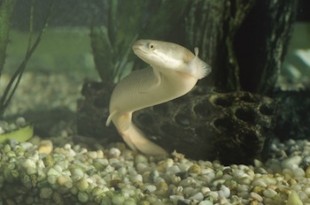Rice University biologist contributed to ‘electrifying’ Science paper
George Phillips certainly got a charge out of the most recent issue of Science.
The Rice University computational biologist is co-author on a paper detailing a 10-year effort that determined a variety of fish with electric organs evolved those organs by similar means.
The researchers found that over time, a genetic toolbox used by independently evolved fish turned muscles into electric organs able to deliver shocks to enemies, navigate and even communicate.

Rice University computational biologist George Phillips is part of a team that reported common genetic mechanisms for the development of electric organs in fish that evolved separately. The finding was reported in the journal Science. Photo by Jeff Fitlow
The work published this week was led by Michael Sussman, director of the Biotechnology Center at the University of Wisconsin-Madison.
Charles Darwin specifically cited fish as important models for understanding the principles of evolution, the researchers wrote. In the new study, they looked at six different lineages of fish, all of which evolved independently and sometimes in vastly different environments, and found that each used essentially the same genes and developmental and cellular pathways to make electric organs.
The ability to obtain and compare genomic sequences is further validation for evolution, Phillips said. “The interesting thing about this article is not the technology or the genome assembly stuff but the biology, the observation that these different animals all converted their muscle cells to electric cells by turning down the things that muscle cells normally do and turning up the parts that make electricity.”
Phillips’ part began while he was a professor at Madison, where he spent 12 years before he returned to Rice.
“I helped provide the computational infrastructure to do the assembly of the genomic DNA and the transcriptomic RNA,” he explained. “There’s a lot of nucleic acid sequencing involved in this work. It comes off in short bits that are pretty worthless until they’re assembled into at least a first draft of the entire genome.” Phillips’ team also helped with the RNA transcriptomes.
“We mapped them onto the genomic DNA in order to see what cellular components have been up- or down-regulated through evolution,” he said. “It’s a good bit of computational work putting those sequences together before you even get to any biological questions.”
Electric organs are found only in fish, the researchers noted, but they’re in a lot of fish. They’re found all around the world in six broad lineages and are, in Darwin’s view, a great example of convergent evolution: Unrelated organisms independently evolve similar traits to adapt to their environments or a particular ecological niche.

Electric eels and other fish that have evolved electric organs have done so by using similar genetic tools, scientists have found. Photos.com
Some deliver a more powerful jolt than a wall socket through a cascade of electrical activity that moves from cell to cell much like power flows serially through batteries in a flashlight, the researchers wrote.
The new work started with the South American electric eel. The team compiled the first draft assembly of its complete genome and compared it with data from other lineages. That allowed them to trace common genomic pathways that led the fish to ramp up the native voltage in cells that enables muscle to contract.
Millions of such cells in a six-foot electric eel help it deliver a jolt of about 600 volts, Sussman said, making it a top predator. It is “in essence, a frog with a built-in five-and-a-half-foot cattle prod,” he said.
“I consider ‘exotic’ organisms such as the electric fish to be one of nature’s wonders and an important ‘gift’ to humanity,” Sussman said. “Our study demonstrates nature’s creative powers and its parsimony, using the same genetic and developmental tools to invent an adaptive trait time and again in widely disparate environments.
“By learning how nature does this, we may be able to manipulate the process with muscle in other organisms and in the near future, perhaps use the tools of synthetic biology to create electrocytes for generating electrical power in bionic devices within the human body or for uses we have not thought of yet.”
“The technology for doing this kind of work has been around for a while,” said Phillips, who has advised researchers on the project since returning to Houston. “Mike Sussman, my buddy and our ringleader, has been a pioneer in recognizing the important biological problems to which we can apply these technologies.
“I’m a general computational biologist and this work sits in my realm. I’m sort of agnostic, many times, about what it gets used for,” he said. “Biology is so diverse, there’s no end to things you can apply this to. It just so happened that electric eels captured Sussman’s attention awhile back.”
The National Science Foundation, the W.M. Keck Foundation and the National Institutes of Health funded the research.


Leave a Reply